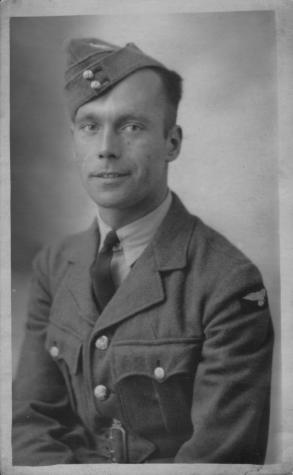Harold Dronfield (1914 - 1942)
Military Career
Sgt Harold Dronfield died, aged 28, on 26 Jun 1942. He was a member of the
Royal Air Force Volunteer Reserve and an air gunner in Squadron 78 of Bomber
Command. Harold was on board a Handley Page Halifax II with R A Brown (W/O)
and J A Whittingham (F/O). They took off from Middleton St. George on a Day/Night
Raid as part of Operation Bremen on 25 Jun 1942. There was 90% moon. 960
Bomber Command aircraft were joined by 102 from Coastal Command. The stiff
wind that kept cloud cover away by day dropped, allowing cloud to form over the
target and made identification difficult. Attack mainly centred on the Focke-Wulf
factory and the A. G. Weser and Deschimag shipyards. Gee equipped markers lit
fires which most bombers then bombed, making the results more impressive than
the Essen 1000 bomber raid. Very high OTU losses due to old aircraft and
inexperience, making total losses 5%. 91 Group lost 11.6% of its aircraft.
The aircraft with Harold on-board was shot down by a night-fighter and crashed into the IJsselmeer.
The official description lists the full crew, some of whom presumably parachuted out and became prisoners of war.
Pilot Officer J A Whittingham, Sergeant H Dronfield: killed; Sergeant G Gibson, Sergeant D B Donaldson, Sergeant A Springthorpe, Sergeant R A Brown:
prisoners of war; Halifax W1067, 78 Squadron, aircraft failed to return from an operational flight over Bremen, Germany, 26 June 1942.
Operation Bremen in World War II
Using every available aircraft in RAF Bomber Command and some of other commands, a thousand-bomber raid was mounted against Bremen. 1,067 aircraft (472
Wellingtons, 124 Halifaxes, 96 Lancasters, 69 Stirlings, 51 Blenheims, 50 Handley Page Hampdens, 50 Whitleys, 24 Douglas Bostons, 20 Manchesters and de Havilland
Mosquitos), 102 Lockheed Hudsons and Wellingtons of RAF Coastal Command, and 5 RAF Army Cooperation Command. Those of No. 5 Group RAF - 142 aircraft –
bombed the Focke-Wulf factory; 20 Blenheims were allocated to the AG Weser shipyard; the RAF Coastal Command aircraft were to bomb the DeSchiMAG shipyard; all
other aircraft were to carry out an area attack on the "town and docks". The limited success was entirely due to the use of GEE, which enabled the leading crews to start
marker fires through the cloud cover. 696 Bomber Command aircraft were able to claim attacks on Bremen.
572 houses were completely destroyed and 6,108 damaged. 85 people were killed, 497 injured and 2,378 bombed out. At the Focke-Wulf factory, an assembly shop was
completely flattened, 6 buildings were seriously damaged and 11 buildings lightly so. The Atlas Werke, the Bremer Vulkan shipyard, the Norddeutsche Hütte, the Korff
refinery, and two large dockside warehouses were also damaged. 48 Bomber Command aircraft were lost (a new record[clarification needed] 5% of those dispatched),
including 4 which came down in the sea near England from which all but 2 crew members were rescued. This time, the heaviest casualties were suffered by the OTUs of
No. 91 Group RAF, which lost 23 of the 198 Whitleys and Wellingtons provided by that group, a loss of 11.6 per cent. 5 of the 102 Coastal Command aircraft were also
lost.










